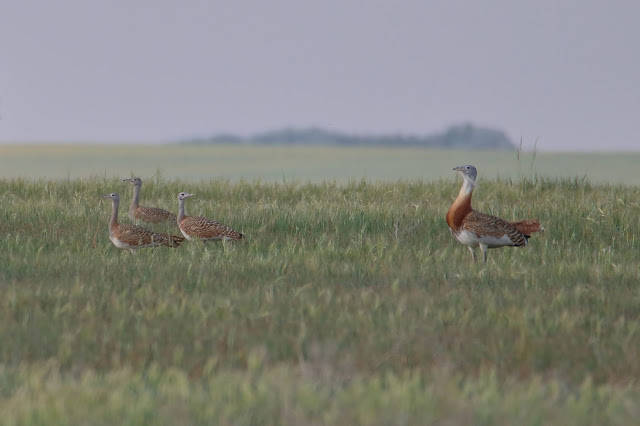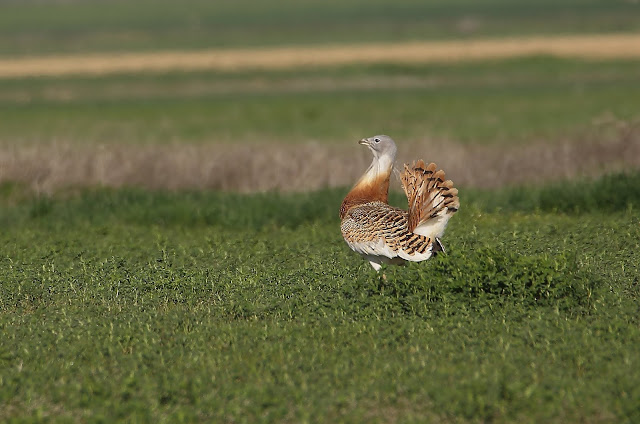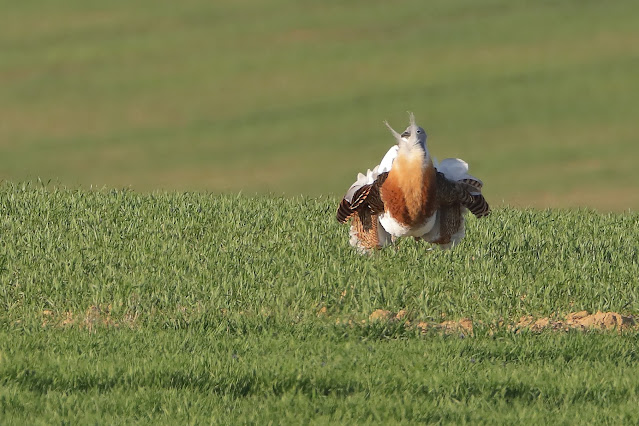Hola una vez más.
Hi again.
Hi again.
En el siguiente enlace podéis ver nuestros próximos viajes fotográficos y de observación de aves y mamíferos nacionales y al extranjero. Espero que os gusten y os animéis a venir conmigo. Una experiencia que nunca olvidareis. Estos viajes están condicionados a la situación en que se encuentren los destinos con respecto a la pandemia del coronavirus.
In the following link you can see our next national and foreign Birds and Mammals photographic and observation trips. I hope you like them and I encourage you to come with me. An experience that you will not forget. These trips are conditioned to the situation in which the destinations are with respect to the coronavirus pandemic.
Hoy os voy ha hablar del gigante de las estepas cerealistas españolas. La avutarda común (Otis tarda).
Today I am going to talk to you about the giant of the Spanish cereal steppes. The Great Bustard.
Today I am going to talk to you about the giant of the Spanish cereal steppes. The Great Bustard.
La avutarda común son grandes
aves pertenecientes a la familia de los Otidae y es el único
representante del género Otis. Se la conoce con el nombre científico de Otis
Tarda. Hay reconocidas dos subespecies, Otis tarda tarda que está
distribuida por Europa, norte de África y oeste de Asia. La otra subespecie es
la Otis tarda dybowskii que son los ejemplares del este de Asia.
The Great Bustard are large birds belonging to the Otidae family and it is the only representative of the Otis genus. It is known by the scientific name of Otis tarda. There are two recognized subspecies, Otis takes lateOtis tarda tarda, which is distributed in Europe, North Africa and West Asia. The other subspecies is the Otis tarda dybowskii, which are the specimens from East Asia.
The Great Bustard are large birds belonging to the Otidae family and it is the only representative of the Otis genus. It is known by the scientific name of Otis tarda. There are two recognized subspecies, Otis takes lateOtis tarda tarda, which is distributed in Europe, North Africa and West Asia. The other subspecies is the Otis tarda dybowskii, which are the specimens from East Asia.
Las poblaciones de África y
Europa son sedentarias mientras que las asiáticas hacen migraciones desde el
norte hasta el sur para pasar el invierno.
The populations of Africa and Europe are sedentary while the Asian ones migrate from the north to the south to spend winter.
The populations of Africa and Europe are sedentary while the Asian ones migrate from the north to the south to spend winter.
Aunque son una especie
considerada como residentes, es cierto que realizan movimientos estacionarios
de bastante distancia relacionados con las estaciones del año, siendo las
hembras las que más realizan este tipo de desplazamientos. En cualquier caso,
se trata de un ave gregaria.
Although they are a species considered as residents, it is true that they carry out stationary movements of quite a distance related to the seasons of the year, with females being the ones that carry out this type of movement the most. In any case, it is a gregarious Bird.
Although they are a species considered as residents, it is true that they carry out stationary movements of quite a distance related to the seasons of the year, with females being the ones that carry out this type of movement the most. In any case, it is a gregarious Bird.
Grupo de avutarda comunes machos en primavera.
Flock of male Great Bustard in spring.
Flock of male Great Bustard in spring.
En España se encuentran distribuidas
en las llanuras cerealistas de ambas Castillas y Extremadura y núcleos menos
importantes en Andalucía, Aragón y Murcia.
In Spain they are distributed in the cereal plains of both Castillas and Extremadura and less important nuclei in Andalusia, Aragon and Murcia.
Macho de avutarda común en
plumaje nupcial.
Male Great Bustard in breeding plumage.
Son aves muy corpulentas y
pesadas que les gusta pasearse por los campos cerealistas de nuestro
territorio. Existe mucha diferencia entre los machos y las hembras en cuanto al
tamaño y su peso.
Male bustard in nuptial plumage. They are very stout and heavy Birds that like to walk through the cereal fields of our territory. There is a lot of difference between males and females in terms of size and weight.
Los machos pueden alcanzar una
altura de 90 a 105 centímetros y una envergadura de 2,1 a 2,7 metros. Su peso
oscila de 9,5 a 16 kilogramos, aunque el récord en España lo ostenta un macho
que llegó a pesar 19 kilogramos. Por ello la convierte en una de las aves
voladoras más pesadas del mundo.
Males can reach a height of 90 to 105 centimeters and a wingspan of 2.1 to 2.7 meters. Their weight ranges from 9.5 to 16 kilograms, although the record in Spain is held by a male who weighed 19 kilograms. For this reason, it makes it one of the heaviest flying birds in the world.
Además de su tamaño, el macho se
diferencia de la hembra por tener un tono más vivo en el dorso de castaños y
dorados. Además, el macho en plumaje nupcial presenta unas plumas largas,
apuntadas y rígidas que le nacen de la mandíbula inferior.
In addition to its size, male differs from female by having a brighter tone on the back of chestnut and gold. In addition, the male in breeding plumage has long, pointed and rigid feathers that are born from the lower jaw.
Detalle de la cabeza del macho
con sus bigotes.
Detail of the male's head with its whiskers.
Detail of the male's head with its whiskers.
Las hembras son sensiblemente más
pequeñas, un tercio en relación con los machos, midiendo 75 a 85 centímetros de
alto y una envergadura alar de 180 centímetros. Su peso medio es de 3,1 a 8
kilogramos.
Females are noticeably smaller, one third in relation to the males, measuring 75 to 85 centimeters high and a wingspan of 180 centimeters. Their average weight is 3.1 to 8 kilograms.
Females are noticeably smaller, one third in relation to the males, measuring 75 to 85 centimeters high and a wingspan of 180 centimeters. Their average weight is 3.1 to 8 kilograms.
Hembra de avutarda común menos llamativa que el macho.
Less conspicuous female bustard than male.
Less conspicuous female bustard than male.
Carece de los bigotes que el macho desarrolla en plumaje nupcial y su color es más apagado.
She lacks the whiskers that male develops in breeding plumage and its color is duller.
En esta toma se puede ver la
diferencia de tamaño entre el macho y las hembras.
In this shot you can see the difference in size between male and he female.
In this shot you can see the difference in size between male and he female.
Su alimentación es a base de vegetales
e invertebrados, siendo estos últimos su dieta predilecta en primavera y
comienzos del verano donde los saltamontes y los grillos son ávidamente
devorados. Ocasionalmente no descartan algún vertebrado como pequeños roedores
y lagartijas. Durante el invierno las leguminosas adquieren su principal fuente
de alimento.
Their diet is based on vegetables and invertebrates, the latter being their favorite diet in spring and early summer where grasshoppers and crickets are eagerly eaten. Occasionally they do not rule out some vertebrates such as small rodents and lizards. During winter, legumes acquire their main source of food.
Their diet is based on vegetables and invertebrates, the latter being their favorite diet in spring and early summer where grasshoppers and crickets are eagerly eaten. Occasionally they do not rule out some vertebrates such as small rodents and lizards. During winter, legumes acquire their main source of food.
Siempre me impresiona ver lo bien
que estas pesadas aves vuelan. Como su
envergadura no es muy grande y su peso es elevado, para alzar el vuelo
necesitan dar unos cuantos pasos aleteando fuertemente para poder despegar.
It always amazes me how well these heavy birds fly. As their wingspan is not very large and their weight is high, to take flight they need to take a few steps, flapping strongly to take off.
It always amazes me how well these heavy birds fly. As their wingspan is not very large and their weight is high, to take flight they need to take a few steps, flapping strongly to take off.
Un grupo levantando el vuelo.
A flock taking off.
A flock taking off.
Otro más numeroso y volando a mayor altura.
Another more numerous and flying higher.
Un gran macho en Vuelo.
A big male in flight.
Otros dos.
Other two.
Dos hembras.
Two females.
El periodo reproductor
comienza a mediados de marzo y se extiende hasta junio. Los machos ya comienzan
a cambiar su plumaje de invierno a nupcial a mediados de enero y en este tiempo
comienzan a luchar para determinar quién ocupara los lugares más vistosos para
realizar la parada nupcial que se la llama rueda.
Their breeding period
begins in mid-March and lasts until June. Males already begin to change their
plumage from winter tobreeding in mid-January and at this time they begin to
fight to determine who will occupy the breter places to make the beeding
display called "la rueda".
Machos midiendo fuerzas.
Males measuring their strength.
Durante esta época los machos
caminan pavoneándose con la cola levantada y con su plumaje nupcial que es muy
bonito.
During this time males strut around with their tails raised and with their breeding plumage which is very beautiful.
During this time males strut around with their tails raised and with their breeding plumage which is very beautiful.
Algunos machos pavoneándose.
Some males strutting.
Some males strutting.
Pero lo que más impresiona de estas grandes aves es su ciclo reproductivo. Desde mediados de marzo a principios de mayo los machos se congregan en una amplia zona donde realizan las paradas nupciales, Las Ruedas. Este tipo de comportamiento recibe el nombre de lek agregado o lek poligínico disperso.
But what is awesome about these large Birds is their brreding cycle. From mid-March to early May, males congregate in a large area where they make their breeding display, "Ruedas". This type of behavior is called an aggregate lek or sparse polygynous lek.
Las manchas blancas diseminadas por los cultivos son los machos de avutarda común realizando la rueda.
The white spots scattered throughout the crops are the male Great Bustard making the "rueda".
Macho haciendo la rueda y una hembra que se acerca a ver si le gusta ese macho.
Male performing the "rueda" and a female who comes to see if she likes that male.
El plumaje reproductor de los machos ya está listo en enero y es desde este momento hasta el comienzo de las paradas nupciales cuando los machos establecen sus dominancias entre sus grupos. Tras la cópula, las hembras depositan en una ligera depresión en el suelo los 2 o 3 huevos que componen la puesta y que incuban durante 21–28 días. Son ellas las que llevan a cabo todo el proceso de incubación y cuidado de los pollos.
The breeding plumage of males is already on in January and it is from this moment until the beginning of the breeding cycle when males establish their dominances among their groups. After copulation, females deposit the 2 or 3 eggs that make up the clutch in a slight depression in the ground and which incubate for 21–28 days. They are who carry out the entire process of incubation and care of chicks.
Un gran macho en el primer estado de la parada nupcial o rueda.
A large male in the first stage of the nuptial parade or "rueda".
Acto seguido, se inclina hacia delante, gira las alas exponiendo su plumaje blanco y con las plumas secundarias hacia arriba. Las bigoteras rectas hacia arriba escondiendo su pico. Las bigoteras las mueve indistintamente pues cuando se acerca una hembra puede bajar la del lado de la hembra para verla mejor. En resumen, se convierte en una bola blanca.
Then, it leans forward, turns its wings exposing his white plumage and with the secondary feathers up. The whiskers straight upwards hiding their beak. Whiskers are moved indistinctly because when a female approaches, he can lower the one on the female's side to see her better. In short, it becomes like white ball.
Unas imágenes valen más que mil palabras.
It is better to show you with some photographs.
Como durante esta fase del cortejo las avutardas están muy expuestas, se recomienda su observación a bastante distancia con la utilización de telescopios terrestres pues ellas mantendrán una distancia bastante grande con los observadores.
As during this phase of the courtship Great Bustards are very exposed, it is recommended to observe them at a considerable distance with the use of ground-based telescopes since they will maintain a fairly large distance from the observers.
Si queréis suscribiros a este blog de los viajes que hacemos pincha en el siguiente enlace: Suscribirse y haz clic en ¿ Quieres suscribirte a nuestro blog?
If you want to subscribe to this post about the trips we do, click on the following link: Susbcribe and click on: Do you want to subscribe to our blog?
Espero que os haya gustado y hasta pronto.
I hope you like it and see you soon.






























Espectaculares fotos y muy instructivo el relato.
ResponderEliminarGracias Luis.
Muchas gracias Antón, me alegra que te haya gustado. Te he eliminado el comentario anterior pues ponía lo mismo.
EliminarSaludos,
Luis
Una entrada muy detallada e interesante.
ResponderEliminarMuchas gracias Kirsten. Me alego que te haya gustado.
EliminarSaludos,
Luis